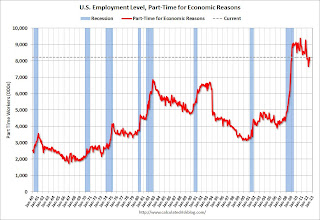by Calculated Risk on 7/06/2012 10:54:00 AM
Friday, July 06, 2012
Employment: Another Weak Report (more graphs)
Another month, another disappointing employment report.
The economy has added 902,000 jobs over the first half of the year (952,000 private sector jobs). At this pace, the economy would add around 1.9 million private sector jobs in 2012; less than the 2.1 million added in 2011.
However job growth has really slowed over the last three months with only 225,000 payroll jobs added (a 900,000 annual pace), and only 274,000 private sector jobs (a 1.1 million annual pace). This is very sluggish employment growth.
The unemployment rate was unchanged at 8.2% in June The household survey showed a another increase in employment (128,000 jobs added), and since the participation rate was unchanged at 63.8%, that was just enough to keep with the increase in the labor force.
U-6, an alternate measure of labor underutilization that includes part time workers and marginally attached workers, increased slightly to 14.9%.
The bottom line is this was another disappointing employment report. Here are a few more graph ...
Employment-Population Ratio, 25 to 54 years old
 Click on graph for larger image.
Click on graph for larger image.
Since the participation rate has declined recently due to cyclical (recession) and demographic (aging population) reasons, an important graph is the employment-population ratio for the key working age group: 25 to 54 years old.
In the earlier period the employment-population ratio for this group was trending up as women joined the labor force. The ratio has been mostly moving sideways since the early '90s, with ups and downs related to the business cycle.
This ratio should probably move back to or above 80% as the economy recovers. So far the ratio has only increased slightly from a low of 74.7% to 75.6% in June (this was down slightly in June.)
Percent Job Losses During Recessions

This graph shows the job losses from the start of the employment recession, in percentage terms - this time aligned at maximum job losses.
In the earlier post, the graph showed the job losses aligned at the start of the employment recession.
Part Time for Economic Reasons
 From the BLS report:
From the BLS report:
The number of persons employed part time for economic reasons (sometimes referred to as involuntary part-time workers) was essentially unchanged at 8.2 million. These individuals were working part time because their hours had been cut back or because they were unable to find a full-time job.The number of part time workers increased in June to 8.21 millon.
These workers are included in the alternate measure of labor underutilization (U-6) that increased in June to 14.9%, up from 14.8% in May.
Unemployed over 26 Weeks
 This graph shows the number of workers unemployed for 27 weeks or more.
This graph shows the number of workers unemployed for 27 weeks or more. According to the BLS, there are 5.37 million workers who have been unemployed for more than 26 weeks and still want a job. This was down from 5.41 million in May. This is generally trending down, but very slowly. Long term unemployment remains one of the key labor problems in the US.
State and Local Government
So far in 2012 - through June - state and local government have lost 20,000 jobs (3,000 jobs were added in June). In the first six months of 2011, state and local governments lost 133,000 payroll jobs - and 230,000 for the year. So the layoffs have slowed.
 This graph shows total state and government payroll employment since January 2007. State and local governments lost 129,000 jobs in 2009, 262,000 in 2010, and 230,000 in 2011.
This graph shows total state and government payroll employment since January 2007. State and local governments lost 129,000 jobs in 2009, 262,000 in 2010, and 230,000 in 2011.Note: Some of the stimulus spending from the American Recovery and Reinvestment Act probably kept state and local employment from declining faster in 2009.
Of course the Federal government is still losing workers (52,000 over the last 12 months and another 7,000 in June alone), but it looks like state and local government employment losses might be ending (or at least slowing sharply).
Overall this was another weak report.


